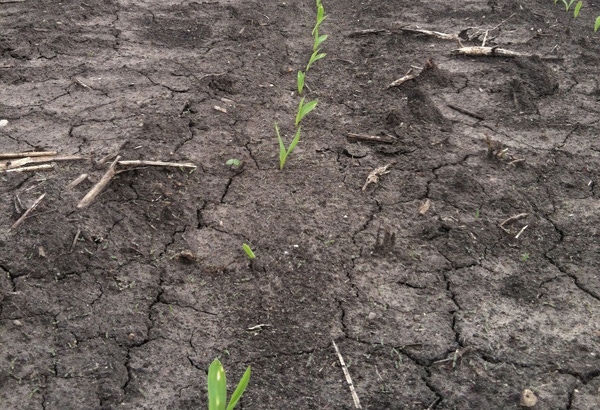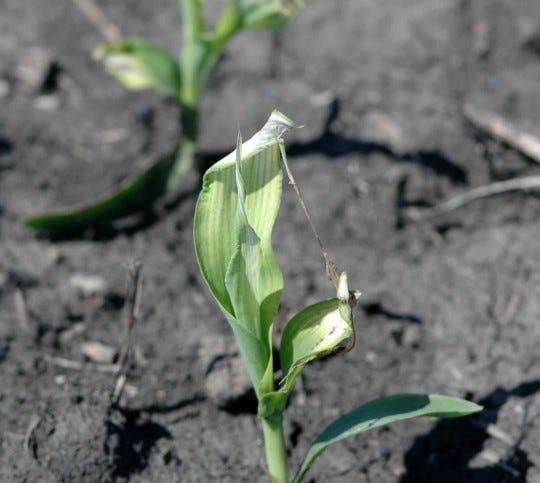May 10, 2017

By Aaron Hager, University of Illinois
Corn Replanting and Herbicide Considerations | The Bulletin: Pest Management and Crop Development Information for Illinois
Following the recent and excessive precipitation, some corn replanting likely will occur when soil conditions are conducive. We hope that replanting occurs only in small areas of a given field, but in some situations entire fields may have to be replanted. While there are many agronomic considerations associated with replanting, some weed control/herbicide issues also should be considered.
Herbicide-resistance traits in the replanted hybrids should be taken into account. For example, if you initially planted a glyphosate-resistant corn hybrid and have areas that need to be replanted, either replant these areas with a similar glyphosate-resistant hybrid or take special precautions to reduce drift with any postemergence glyphosate application if you replant with a non-glyphosate resistant hybrid as these plants will be extremely sensitive to glyphosate.
Is there an interval between when a herbicide was applied and corn replanting? For soil-applied corn herbicides, replanting can proceed whenever field conditions are feasible. However, for some postemergence corn herbicides, there are intervals between application and replanting. For example, if a corn field previously treated with Spirit, NorthStar, Permit, or Yukon is lost due to excessive precipitation and must be replanted, there is a 4-week, 14-day, 1-month, and 1-month, respectively, interval that must elapse between the herbicide application and corn replanting.
While most soil-applied herbicides allow more than one application per season, a few can be applied only once per season. For example, the Acuron and Resicore labels indicate not to reapply if corn is to be replanted. In instances where small areas of a field will be replanted, some may elect to simply replant without applying any additional residual herbicide. If, however, you elect to make a second application of a particular corn herbicide, keep in mind that many product labels indicate a maximum per acre rate that can be applied during one growing season.
If corn plants from the first planting remain, what are some options to control them prior to replanting? Tillage is very effective and consistent at removing existing corn plants, and the replanting operation can proceed at any time afterward. However, tillage might not always be an option. Several herbicide options are available that can be applied to control existing corn plants (Table 1), but careful attention must be given to what, if any, herbicide resistance trait(s) the existing corn plants contain.
Table 1. Options to control existing corn plants prior to replanting.

Corn Replanting and Herbicide Considerations | The Bulletin: Pest Management and Crop Development Information for Illinois
Glyphosate is very effective for controlling existing stands of corn sensitive to glyphosate. Corn replanting can occur immediately after application, but control of existing corn plants might be improved if at least 24 hours elapses between application and replanting. Glyphosate also would control sensitive weeds that might have emerged with the initial stand of corn. Be very cautious to avoid drift when spraying glyphosate, especially if spraying around wet holes.
Other herbicides to control emerged corn include paraquat and glufosinate (only hybrids sensitive to glufosinate), although previous research with these herbicides has demonstrated that complete control is not always achieved. Performance of these produces is often enhanced when applied in combination with atrazine or metribuzin. Paraquat and glufosinate would also control a broad spectrum of emerged weeds.
Corn hybrids resistant to glyphosate, glufosinate, or both can be controlled with Select Max prior to replanting field corn. The label specifies to apply 6 fluid ounces per acre to control glyphosate-resistant field corn up to 12 inches tall. Applications should include NIS and AMS (do not use a COC or MSO in this particular use), and care must be taken to avoid in-field overlaps or excessive injury to the replanted corn might occur. Glyphosate can be tankmixed with the Select Max to control emerged broadleaf weed species. DO NOT replant fields treated in this way sooner than six days after application or severe injury to the replanted corn can occur.
The product labels of Poast, Poast Plus, Fusion, Fusilade, Select, and Assure II include an interval that must elapse between application and rotation to or replanting with grass crops such as corn. These intervals range from 30 (Poast, Poast Plus, Select) to 60 (Fusion, Fusliade), to as many as 120 (Assure II) days, making these products unlikely choices for this particular use. Severe injury to replanted corn can occur if soil residues of any of the ACCase-inhibiting herbicides described herein are taken up by the emerging corn plants (Figure 1).

You May Also Like




